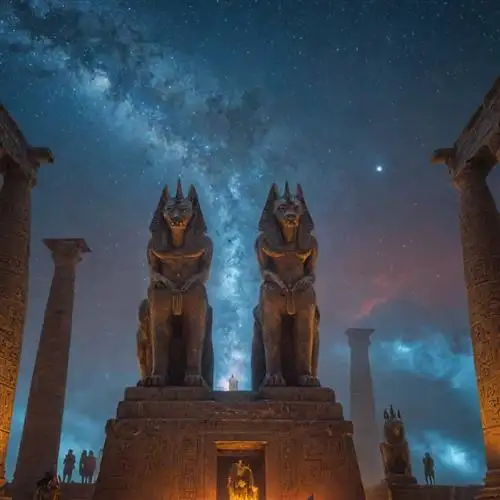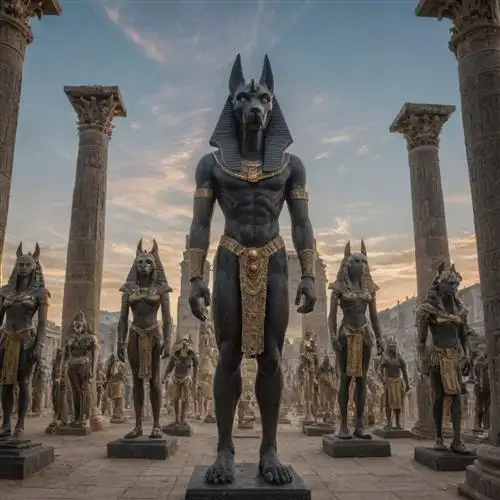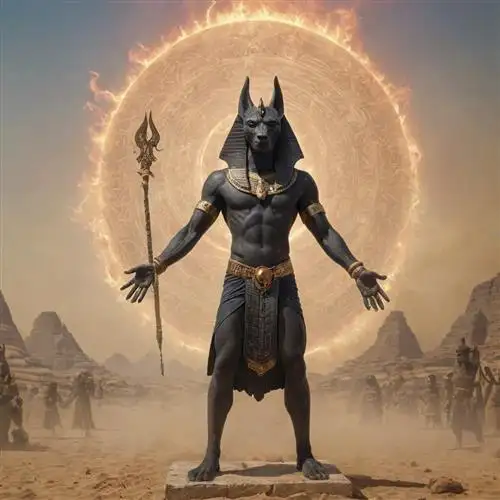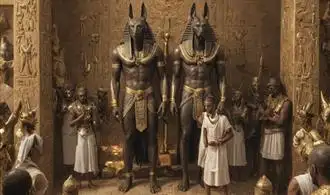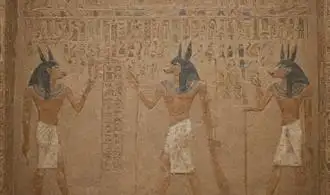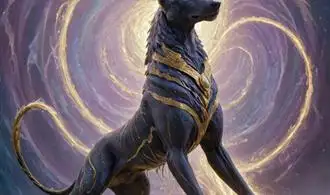
Uncovering the Ancient Roots of Anubis
Anubis, the ancient Egyptian deity associated with mummification and the afterlife, has captivated the imaginations of scholars and enthusiasts alike. Delving into the rich history and symbolism of this enigmatic figure reveals a complexity that transcends the surface-level depictions often encountered. To truly understand Anubis, one must uncover the ancient roots that have shaped his enduring legacy.
The origins of Anubis can be traced to the earliest dynastic periods of ancient Egypt, where he emerged as a prominent figure in the funerary rituals and beliefs of the time. As the jackal-headed god, Anubis was tasked with the crucial role of overseeing the mummification process, ensuring the preservation of the deceased's physical form. This connection to the afterlife and the transition from the mortal realm to the divine realm cemented Anubis' status as a gatekeeper and guide for the deceased.
Interestingly, the association between Anubis and the jackal or wild dog can be linked to the ancient practice of using these animals to aid in the discovery and preservation of the dead. Jackals were often observed scavenging near burial sites, leading the ancient Egyptians to perceive them as guardians of the necropolis. This observation and the reverence for the jackal's role in the funerary process ultimately led to the deification of Anubis as the preeminent deity responsible for the mummification and safekeeping of the dead.
Beyond his primary function as the overseer of mummification, Anubis also held significant symbolic meaning in the ancient Egyptian pantheon. As the son of Ra, the sun god, and Nephthys, the goddess of mourning, Anubis represented the duality of life and death, light and darkness. This dual nature reflected the complexities of the afterlife and the delicate balance between the mortal and divine realms.
In the famous weighing of the heart ceremony, depicted in the Book of the Dead, Anubis is shown as the one who guides the deceased's soul through the underworld and oversees the judgement of their actions. This pivotal role as the psychopomp, or conductor of souls, further solidified Anubis' importance in the ancient Egyptian belief system and the journey of the deceased to the afterlife.
The Transformative Role of Anubis in the Afterlife
Anubis, the jackal-headed deity of ancient Egypt, held a pivotal role in the afterlife. As the god of embalming and the protector of the dead, Anubis guided the souls of the deceased through the intricate and often harrowing journey of the afterlife. His presence was crucial in ensuring the safe passage of the dead from this world to the next, a process that was believed to be both physically and spiritually transformative.
At the heart of Anubis' role was the ritual of mummification, which he oversaw with meticulous care. The process of preserving the physical body was seen as essential for the soul's journey, as it provided a vessel for the departed to inhabit in the afterlife. Anubis would personally oversee the embalming procedures, ensuring that the body was prepared with the utmost care and attention to detail. This attention to the physical form was a reflection of the belief that the soul could not progress without a well-preserved body to return to.
But Anubis' influence extended far beyond the physical realm. He was also responsible for guiding the soul through the rigorous and often daunting trials of the afterlife. The most famous of these was the weighing of the heart ceremony, where the soul's actions and deeds were judged against the feather of truth. Anubis would preside over this crucial moment, ensuring that the scales were balanced and the soul's fate was determined with the utmost fairness and impartiality.
For the Egyptians, the role of Anubis in the afterlife was seen as transformative, both physically and spiritually. The careful preservation of the body and the weighing of the soul were believed to be essential for the departed to achieve eternal life and rejoin the divine realm. Anubis, with his unwavering dedication and steadfast guidance, was the gatekeeper to this profound and sacred transition.
Anubis Symbolism and Its Enduring Significance
Anubis, the jackal-headed deity, has long been revered in ancient Egyptian mythology as the guardian of the dead and the protector of the mummification process. His enduring significance extends far beyond his role as a funerary god, as his symbolic representation encompasses a deep and multifaceted understanding of the human experience.
At the heart of Anubis' symbolism lies the concept of transformation and transition. As the guidepost between the realms of the living and the dead, Anubis presides over the critical moment of death, ensuring the safe passage of the soul to the afterlife. This liminal positioning imbues Anubis with a profound sense of power and mysticism, for he stands at the threshold of the known and the unknown, the tangible and the intangible.
Anubis' jackal-like form is not merely a stylistic choice, but a deliberate representation of his dual nature. The jackal, a creature that thrives in the liminal spaces between the desert and the cultivated lands, embodies the blurring of boundaries and the embrace of the in-between. This duality is echoed in Anubis' role as both a protector and a guide, a figure who navigates the delicate balance between life and death.
Moreover, Anubis' association with mummification and the preservation of the physical body speaks to the enduring human desire to transcend the limitations of mortality. By entrusting the deceased to Anubis' care, the ancient Egyptians sought to ensure the continued existence of the soul, a testament to their profound belief in the cyclical nature of life and death.
Interestingly, the symbolism of Anubis extends beyond the confines of ancient Egyptian culture, finding resonance in various esoteric and spiritual traditions. In modern Wiccan and neo-pagan practices, Anubis is often invoked as a guide and protector, facilitating the exploration of the subconscious and the journey towards self-transformation.
In the realm of Jungian psychology, Anubis' role as a threshold guardian and psychopomp (a guide of souls) has been explored as a metaphor for the processes of individuation and the integration of the shadow self. By confronting the darker aspects of the human psyche, one can, like the deceased in the Egyptian afterlife, undergo a transformative journey towards a more complete understanding of the self.
The Cult of Anubis and Its Cultural Influence
The cult of Anubis, the ancient Egyptian god of the dead, has had a profound and enduring impact on the cultural and spiritual traditions of the region. As the god responsible for the embalming and protection of the dead, Anubis played a central role in the complex funerary rituals and beliefs of ancient Egyptian society.
One of the most significant aspects of the Anubis cult was its influence on the development of mummification practices. Anubis was believed to oversee the process of embalming, which was essential for ensuring the safe passage of the deceased into the afterlife. The intricate techniques and rituals associated with mummification, including the removal of internal organs, the application of preservative substances, and the careful wrapping of the body, were all under the divine purview of Anubis.
Beyond the realm of funerary rites, the cult of Anubis also had a profound impact on the broader cultural and religious landscape of ancient Egypt. Anubis was often depicted alongside other deities, such as Osiris and Isis, in the pantheon of Egyptian gods, highlighting his importance within the complex web of divine relationships that underpinned the Egyptian belief system.
The iconography and symbolism associated with Anubis were also widely disseminated throughout the ancient world, influencing the artistic and architectural traditions of neighboring civilizations. The jackal-headed figure of Anubis, with its distinctive black coloration and piercing gaze, became a powerful and recognizable symbol of death, transition, and the afterlife.
Moreover, the cult of Anubis played a significant role in shaping the social and political structures of ancient Egyptian society. The temple of Anubis, located in Abydos, was a major center of religious and administrative activity, and the priests who served in this temple were held in high regard and wielded considerable influence within the broader community.
Anubis in the Modern Imagination
Anubis, the enigmatic jackal-headed deity of ancient Egyptian mythology, has captivated the modern imagination with its striking visual representation and profound symbolism. While the ancient Egyptians revered Anubis as the guardian of the dead, the god's influence has transcended the boundaries of its original cultural context, finding a new life in various contemporary art forms, literature, and popular culture.
One of the most fascinating aspects of Anubis in the modern imagination is the way it has been reinterpreted and reimagined by artists and writers. From the haunting depictions of the jackal-headed god in fantasy and horror genres to the more nuanced explorations of its role in the afterlife, Anubis has become a symbol of both the mystical and the macabre. In the realm of visual arts, contemporary artists have found inspiration in the striking iconography of Anubis, incorporating its distinctive features into their works to evoke a sense of the ancient and the otherworldly.
Moreover, Anubis has also found a prominent place in the world of literature, with authors weaving the god's mythology into their narratives. From the rich and evocative descriptions of Anubis in historical fiction to the creative reimagining of its role in contemporary fantasy and speculative fiction, the god has become a captivating figure that resonates with modern audiences. These literary interpretations often delve into the deeper symbolic meanings associated with Anubis, exploring themes of death, transformation, and the mysteries of the afterlife.
Interestingly, Anubis has also made its mark in the realm of popular culture, with its distinctive appearance and mythological significance being incorporated into various media, from video games and comic books to film and television. These adaptations have further cemented Anubis' place in the collective consciousness of contemporary audiences, introducing the god to new generations and sparking a renewed interest in ancient Egyptian mythology.
One particularly fascinating aspect of Anubis in the modern imagination is the way it has been reimagined and reinterpreted by diverse cultural perspectives. As the god's influence has spread beyond its original Egyptian context, it has been embraced and reinterpreted by artists, writers, and thinkers from around the world, each bringing their own unique cultural and artistic sensibilities to the table. This cross-cultural dialogue has resulted in a rich tapestry of Anubis-inspired works that reflect the god's enduring relevance and the universal appeal of its mythological significance.
In conclusion, Anubis has undoubtedly captured the modern imagination, transcending its ancient origins to become a multifaceted symbol that resonates with audiences across time and culture. From its striking visual representation to its profound symbolic resonance, the god of the dead continues to inspire and captivate, inviting us to delve deeper into the mysteries of the ancient Egyptian world and the enduring power of mythology.

